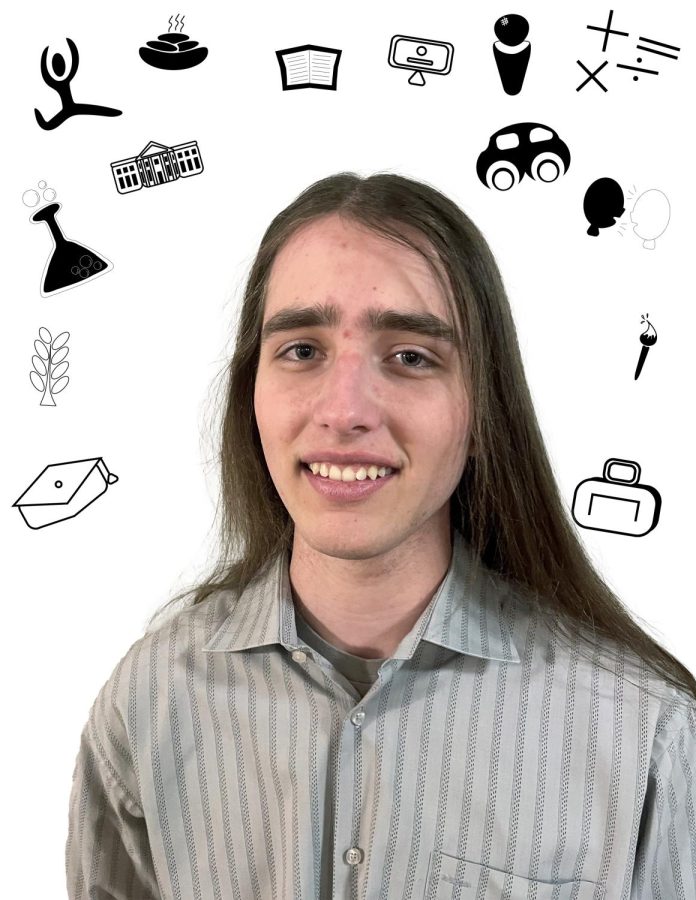Crane Crafts His Way To The Cutting Edge Of Technology
May 10, 2023
Computer sciences are the fields of the future, and are quickly taking over many aspects of our life. Nelson Crane is teaching himself these fields through trial and error, learning how to build and program computers and hardware.
Computers have been a big part of Crane’s life since he was young. The first time he really wanted to try out programming for himself was around the age of six, on Minecraft.
“I started [programming] at 6 or 7,” Crane said, “and there was an early Minecraft mod which added LUA programmable computers, and all of my projects were garbage; they were not good. The mod added a block in-game which was a full computer that you could program, and have it interface with the world and do arbitrary things.”
After spending some time experimenting with Minecraft mods and some programming, Crane signed up for some coding summer camps.
“When I was 12 I went to some short, day-long summer camps through the U,” said Crane. “It was a fairly basic program called Processing, similar to Java, and it was very easy to get things up and running in its environment. That was my first introduction to real programming, and I did that for a few years with little project ideas that had some input and some output and maybe needed to do some text processing.”
Since then Crane has continued to pursue programming, and eventually became interested in the hardware side of computers as well. After that, around a year ago, Crane decided that he wanted to build his own keyboard to improve his ergonomics and efficiency while typing.
“Because of QWERTY’s layout I get wrist pain from it,” Crane said. “Because of that I modified how I used QWERTY. By this time I was getting into the mechanical keyboard community, and I found out you can build a keyboard exactly how you want it with any button wherever you want. So the first thing that needed to go was the [staggered format]. So everything aligned, then I fully split the keyboard so the two halves are completely separate. Finally, I put it into a different layout called Colemak, so the buttons are in different places but it is much nicer to type on.”
Instead of taking any shortcuts with his keyboard, Crane decided to create it from scratch. Although this led to a complete and intimate understanding about how keyboards are made and function, it required a substantial investment of time and effort.
“It’s been about 14 months since I started it,” Crane noted, “and I’ve put in over 100 hours on it. This was my first introduction into C as a programming language, and it was my introduction to soldering, so I taught myself how to solder by doing this project.”
In order to make the keyboard, Nelson had to learn at least two major skills; a programming language and how to solder. Not only that but he had to invest vast amounts of time into finding resources for the keyboard and learning from them so he could make his own completely custom keyboard.
On top of all of this, Crane, like so many creators, had painstakingly fixed mistake after mistake. But he persisted, and just recently he has come to what very well could be the completion of his keyboard project.
“What I’ve learned doing this is that whenever you think you’re done, you’re probably not. There’s gonna be something that didn’t get soldered right, and I’m gonna have to cut it open and re-solder it. I’ve said this a lot of times during this project but, ‘As far as I know, this is done.’”
This is a testament to his ability to work hard and persistently on a project. Crane’s uncle, Andrew Nelson, has seen first-hand how persistent Nelson is with his projects.
“Nelson (Crane) is of course very genuine, smart, and creative,” Nelson said, “But what I admire most is his work ethic and grit. He does not give up when faced with a hard problem and won’t give up until it’s solved. On his keyboard he spent over a hundred hours learning and troubleshooting until he got it working. I really admire that and find it inspirational.”
Andrew Nelson, who works at a tech start-up, has served as a sort of guide for Crane, someone for Crane to ask questions to and bounce ideas off of.
Crane is unsure what exactly he plans to do going forward, but he does plan on going to the University of Utah.
“As it stands I got accepted to the U,” Crane said, “and I’d like to go there because all of the programs I want for engineering seem pretty good and I don’t have to live on campus so I can save around 7,000 a year. I don’t know what I’m gonna major in yet, but probably electrical engineering, mechanical engineering, computer science, or something of the sort. After that, I don’t really know.”
Nelson also sees Crane doing something related to computer sciences in college, and could easily see it being his career.
“Nelson is a born engineer,” said Nelson, “and I see him studying computer technology in college and making it his career. Nelson is very entrepreneurial and it wouldn’t surprise me to see him create a product or start a company- he’s great at seeing a need for something and inventing a solution.”
This assessment fits well with Crane’s current mindset about computer sciences, which is to observe problems that he encounters, like his wrist problems from the QWERTY keyboard, and create custom solutions to them.
As Crane puts it, “I’ll do what I need to do to solve the problem I have.”




























